Prints Cabinet
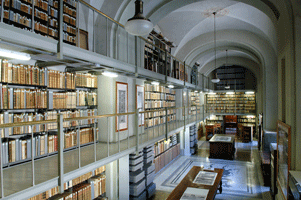 The Prints Cabinet of the Vatican Library is an important artistic collection which preserves engravings and loose prints, i.e. images which are not bound
into books or which are not accompanied by printed texts. It also preserves a considerable number of drawings which have, over the course of time, become part of
the Library’s collections and which were added to the collection of engravings due to the similarity of the necessary conservation measures. It also includes many
photographs and chalcographic and xylographic plates. The Prints Cabinet is made up of five main collections: The Prints Collection, the Geographic Prints
(or Maps) Collection, the Copperplate Collection, the Drawings Collection and the Photographic collection. It also includes some smaller collections, such as the Ashby and Gismondi
collections.
These maintain a certain autonomy inasmuch as they are "closed collections" of a certain size. The Prints Cabinet is enriched by artistic material through bequests, donations, acquisitions,
and especially through the gifts which are made to the Holy Father.
The Prints Cabinet of the Vatican Library is an important artistic collection which preserves engravings and loose prints, i.e. images which are not bound
into books or which are not accompanied by printed texts. It also preserves a considerable number of drawings which have, over the course of time, become part of
the Library’s collections and which were added to the collection of engravings due to the similarity of the necessary conservation measures. It also includes many
photographs and chalcographic and xylographic plates. The Prints Cabinet is made up of five main collections: The Prints Collection, the Geographic Prints
(or Maps) Collection, the Copperplate Collection, the Drawings Collection and the Photographic collection. It also includes some smaller collections, such as the Ashby and Gismondi
collections.
These maintain a certain autonomy inasmuch as they are "closed collections" of a certain size. The Prints Cabinet is enriched by artistic material through bequests, donations, acquisitions,
and especially through the gifts which are made to the Holy Father.
Il Catalogue of Graphic materials and Art objects may be consulted on-line.
HISTORICAL NOTES
 The first reference to a substantial collection of prints in the Vatican Library goes back to 1773, when there were around 30,000 prints. But it was Pope Pius VI Braschi (1775-1799) who pressed
for the initiation of
a prints collection in the Library. In 1785, he wanted to form a Prints Room specifically for the conservation of engravings and prints which were found in the Vatican Library. The Prints Room was thus
established on the same floor as the Salone Sistino, near the Pigna Courtyard, where the Chiaramonti Museum is located today. The pontificate of Pius VI also saw the creation of the first systematic
collection of engravings of the Vatican Library, which is now called the Fondo Antico (or Old Collection). It is a superb collection including more than 17,000 engravings by different artists from
the fifteenth to the eighteenth centuries, in 161 large volumes. Unfortunately, the Prints Room was destroyed only a few years later, in 1820, to make way for the construction of the "New Wing" of
the Vatican Museums. The Library Administration made various vain attempts to save it from demolition. The collection of engravings was initially transferred to the Sala del Sansone
(which later became the Sala delle Nozze Aldobrandini), and later to the ninth room of the Borgia Apartment, where it was kept throughout the nineteenth century.
Franz Ehrle, first as Prefect (1895-1914) and then as Cardinal Librarian of the Holy Roman Church (1929-1934) was a notable promoter of the care and study of this sector of the Library. Fr. Ehrle encouraged
the study of the topography of Rome and the territories under the Patrimony of St. Peter’s, and he recognized the necessity of establishing a Curator for Prints. From 1921 the Prints Cabinet was directed by
Lamberto Donati (1890-1982), who was given the title Person in charge of the Prints Section (Incaricato del Reparto delle Stampe). The collections were arranged according to the format system, which is still in
use today; the works were catalogued; and hand-written inventories of certain volumes of the Fondo Antico were produced, as well as index cards for the same volumes. Donati’s prominence as a scholar gave
credibility to the Cabinet and helped in establishing a rapport with other Italian and international institutions of similar nature. In 1936, he was responsible for the founding of the periodical Maso Finiguerra.
Rivista della stampa incisa e del libro illustrato […] ("Journal of printed engravings and illustrated books"). It was under his directorship that additional important collections,
such as the Ashby and the Guglielmi collections, were also acquired. The current organization of the Prints Cabinet goes back to the pontificate of Pius XI, who wanted the collection to be placed in
the large vaulted hall room adjacent to the Borgia apartment which had once been the site of the papal Armory, and later of the Vatican School of Mosaics. The transferal of the collections to
their current location took place in 1932, and the room was inaugurated by the Pope himself. The Cicognara Collection, rich with prints and art books, and therefore a good complement to the engravings
collections, was later placed in the same site.
The first reference to a substantial collection of prints in the Vatican Library goes back to 1773, when there were around 30,000 prints. But it was Pope Pius VI Braschi (1775-1799) who pressed
for the initiation of
a prints collection in the Library. In 1785, he wanted to form a Prints Room specifically for the conservation of engravings and prints which were found in the Vatican Library. The Prints Room was thus
established on the same floor as the Salone Sistino, near the Pigna Courtyard, where the Chiaramonti Museum is located today. The pontificate of Pius VI also saw the creation of the first systematic
collection of engravings of the Vatican Library, which is now called the Fondo Antico (or Old Collection). It is a superb collection including more than 17,000 engravings by different artists from
the fifteenth to the eighteenth centuries, in 161 large volumes. Unfortunately, the Prints Room was destroyed only a few years later, in 1820, to make way for the construction of the "New Wing" of
the Vatican Museums. The Library Administration made various vain attempts to save it from demolition. The collection of engravings was initially transferred to the Sala del Sansone
(which later became the Sala delle Nozze Aldobrandini), and later to the ninth room of the Borgia Apartment, where it was kept throughout the nineteenth century.
Franz Ehrle, first as Prefect (1895-1914) and then as Cardinal Librarian of the Holy Roman Church (1929-1934) was a notable promoter of the care and study of this sector of the Library. Fr. Ehrle encouraged
the study of the topography of Rome and the territories under the Patrimony of St. Peter’s, and he recognized the necessity of establishing a Curator for Prints. From 1921 the Prints Cabinet was directed by
Lamberto Donati (1890-1982), who was given the title Person in charge of the Prints Section (Incaricato del Reparto delle Stampe). The collections were arranged according to the format system, which is still in
use today; the works were catalogued; and hand-written inventories of certain volumes of the Fondo Antico were produced, as well as index cards for the same volumes. Donati’s prominence as a scholar gave
credibility to the Cabinet and helped in establishing a rapport with other Italian and international institutions of similar nature. In 1936, he was responsible for the founding of the periodical Maso Finiguerra.
Rivista della stampa incisa e del libro illustrato […] ("Journal of printed engravings and illustrated books"). It was under his directorship that additional important collections,
such as the Ashby and the Guglielmi collections, were also acquired. The current organization of the Prints Cabinet goes back to the pontificate of Pius XI, who wanted the collection to be placed in
the large vaulted hall room adjacent to the Borgia apartment which had once been the site of the papal Armory, and later of the Vatican School of Mosaics. The transferal of the collections to
their current location took place in 1932, and the room was inaugurated by the Pope himself. The Cicognara Collection, rich with prints and art books, and therefore a good complement to the engravings
collections, was later placed in the same site.
COLLECTIONS
PRINTS COLLECTION


The Prints Collection is quite diverse, since it brings together many different kinds of works which were acquired by various means and in various times: engravings of Old Masters, prints of
the nineteenth century, panoramas from the seventeenth and eighteenth centuries, lithographs and also a few photographs. This collection was first established in the early decades of the twentieth century and,
as with other General Collections of the Vatican Library, it is an “open collection”, meaning it continues to be added to. It is arranged according to format and includes the following seven categories:
The Stampe I format currently includes 267 groups (folders or volumes) of prints, totaling about 13,500 works. It contains prints of small format, including works by Giulio Bonasone, Israel Silvestre, Jacques Callot,
Peter Schenk, Stefano Della Bella, Antonio Acquaroni, Philippe Galle and many other artists.
.gif) The Stampe II format currently includes 376 groups of prints, totaling about 15,000 works. It contains prints of small to medium format, including works by Bartolomeo Pinelli, Etienne Dupérac, Giacomo Lauro,
Giovanni Battista Falda, Domenico Amici, Antonio Tempesta, Francisco Goya, Giovanni Maria Mitelli, Giovanni Battista Cipriani, and Joseph Anton Koch. There is a rich collection of nineteenth-century French fashion
prints, and prints by many other artists.
The Stampe II format currently includes 376 groups of prints, totaling about 15,000 works. It contains prints of small to medium format, including works by Bartolomeo Pinelli, Etienne Dupérac, Giacomo Lauro,
Giovanni Battista Falda, Domenico Amici, Antonio Tempesta, Francisco Goya, Giovanni Maria Mitelli, Giovanni Battista Cipriani, and Joseph Anton Koch. There is a rich collection of nineteenth-century French fashion
prints, and prints by many other artists.
The Stampe III format currently includes 407 groups of prints, totaling about 15,000 works. It contains prints of medium format, including works by Adrien Manglard, Canaletto, Cornelis Bloemaert, Giovanni Battista Nolli,
Antonio Tempesta, Antonio Acquaroni, Pietro Santi Bartoli, Richard Cooper, and many other artists.
The Stampe IV format currently includes 250 groups of prints, totalling about 8,000 works. It contains works of large format, including engravings by Giovanni Battista Piranesi, Bartolomeo Pinelli, Antonio Canova,
miscellaneous Italian panoramas, works of the Calcographie du Louvre, and works by many other artists.
The Stampe V format currently includes 344 groups of prints, totaling about 19,000 pieces. The works of the Fondo Antico, which contains the rarest, most precious, and most historically significant collections of
the Prints Cabinet of the Vatican Library are held in this collection.
.gif)
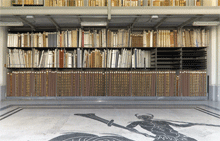 The Fondo Antico is made up of 161 in-folio volumes which were bound and gathered as a collection of engravings in the late 1700's. The volumes, which all have the same vellum binding decorated with
floral designs in gold, bear the shelf-marks Stampe V.3 – Stampe V.163, and contain a total of about 15,000 prints. They are arranged according to a subdivision by schools: engravings of the Italian school were
placed first (72 volumes), then those of the German school (16 volumes), the Flemish school (30 volumes), the French school (18 volumes), and finally a miscellany subdivided according to subject matter:
Antiquities (4 volumes), Miscellaneous Sacred (4 volumes), Miscellaneous Secular (2 volumes), Portraits (2 volumes), Prints of Towns, Prints of Panoramas,
Architectural Prints, and Vases and Garnishes, for a
total of 15 volumes of Miscellaneous Prints.
The Fondo Antico is made up of 161 in-folio volumes which were bound and gathered as a collection of engravings in the late 1700's. The volumes, which all have the same vellum binding decorated with
floral designs in gold, bear the shelf-marks Stampe V.3 – Stampe V.163, and contain a total of about 15,000 prints. They are arranged according to a subdivision by schools: engravings of the Italian school were
placed first (72 volumes), then those of the German school (16 volumes), the Flemish school (30 volumes), the French school (18 volumes), and finally a miscellany subdivided according to subject matter:
Antiquities (4 volumes), Miscellaneous Sacred (4 volumes), Miscellaneous Secular (2 volumes), Portraits (2 volumes), Prints of Towns, Prints of Panoramas,
Architectural Prints, and Vases and Garnishes, for a
total of 15 volumes of Miscellaneous Prints.
Other groups of large engravings are also contained in the Stampe V format. Notable among these are two volumes of prints with a total of 285 works by various artists of the sixteenth and seventeenth centuries,
which come from the collection of Gregorio Acquaviva d’Aragona and were donated to the Library in 1802 (Stampe V.1 – Stampe V.2).
The Stampe VI format is made up of three volumes of large format which contain engravings of the Speculum Romanae magnificentiae by Antonio Lafréry. There are about 200 works in this collection. Two sections come from the Ashby collection (q.v.).
The Stampe VII format is made up of 84 groups of prints with a total of about 1,000 works. These large size prints come from the Calcografie du Louvre, and are interpretations of well-known works by various artists, primarily French, from the seventeenth and eighteenth centuries.
GEOGRAPHIC PRINTS (MAPS) COLLECTION
Il The Geographic Prints Collection includes loose cartographic, geographic and topographic engravings, prints and images. Such works are also preserved in many other collections of the Library
(e.g. Raccolta Generale Geografia; Raccolta Generale Storia; the Barberini and Chigi collections).

It is therefore impossible to give an exact number of “geographic” prints held in the Library. This collection was initiated in the first
decades of
the twentieth century together with the Library's other "General Collections" (Raccolte Generali); like these, it is an “open” collection which is continually added to. It is currently composed of about 1,700 works.
However, many engravings of this type which are kept in the Prints Cabinet have not yet been inventoried, so that the number will undoubtedly increase over the next few years. The collection is divided into
five categories according to format: I, II, Oversized, Scrolls, and Oversized Scrolls. The Stampe Geografiche I format is a collection of about 650 works of medium format (many of which are maps of more than
one sheet) containing maps of Italian and European cities and other maps from the sixteenth to the twentieth centuries. Among these are works by Giacomo Gastaldi, Paolo Furlani, Donato Bertelli, Hieronymus Cock,
Matteo Florimi, Pirro Ligorio, Abraham Ortelius, Nicolò Beatricetto, Etienne Dupérac, Giovanni Maggi and many other artists and editors. A considerable part of this collection is represented by maps and panoramic
views of Rome. There are copies and various editions of many of these works. A selection of the 19 best maps of Rome have been placed in the Reserve (Riserva-St.Geogr. I 620-638). Among these are the ichnographic
map by Leonardo Bufalini (1551) and those of Antonio Tempesta (1606 edition; a very rare first edition copy of this map, from 1593, is kept separately under Riserva S.79), Timanno van Veen (1593),
Giovanni Battista Falda (1698 edition), Ambrogio Brambilla, Nicolò Beatricetto, Pirro Ligorio and others. The Stampe Geografiche II format includes about 200 works of small format containing maps of Italian
and foreign cities and of Italian and other European localities from the sixteenth to the twentieth centuries. Among these are works of Giacomo Lauro, Pierre Mortier, Ambrogio Brambilla, Matteo Florimi,
Giovanni Maria Cassini, Pietro Ruga and many others. The Stampe Geografiche S (Stragrandi, or oversized) format contains about 550 medium to large sized depictions of cities and geographic drawings from
the sixteenth to the twentieth centuries. Among these is the famous map of Venice by Jacopo de Barbari (1500), the map of Naples by Duca di Noja, and many other maps of cities, especially of Rome
and the Pontifical State. This collection also includes 50 scrolls and oversized scrolls, among which is a most interesting watercolor exemplar of the map of Rome by Antonio Tempesta (1664 edition)
and a framed copy of the Prospetto dell'Alma Città di Roma by Giuseppe Vasi (1765). The Geographic Prints Collection of the Library also once included a number of terrestrial and celestial globes,
which are now preserved in the exposition halls of the Vatican Museums. The most notable of these is undoubtedly the copper and niello Mappamondo Borgiano (Borg. XVI). Also in the Vatican Museums
today are three celestial and two terrestrial globes by Matthias Greuter (1564-1638), three globes by Jan Blaeu (1596-1673), one by Giovanni Battista Nicolosi, and many optical instruments.
Many “geographic” engravings are also preserved in the Prints Collection: the Map of Naples by Duca di Noja (Stampe IV.38), an exemplar of the Map of Rome by G.B. Nolli (Stampe III.71), and many
other such works
COPPERPLATE COLLECTION
The Prints Cabinet preserves more than 1,300 chalcographic plates. This collection has no particular uniformity; it is made up of plates of various origins. About 100 of the plates come
from the Archives of the Chapter of S. Maria Maggiore, including works from various periods between the sixteenth and eighteenth centuries. Among these is the particularly notable plate done by Giovanni Maggi
(1566-1618) at the beginning of the seventeenth century for the building and the gardens of the Quirinale.

In addition, there are about 70 copperplates relating to the illustrations in Filippo Bonanni’s volume, Numismata pontificum romanorum, published in Rome in 1699. More than 400 plates come from the Borghese collections
and represent the illustrations to three books by Ennio Quirino Visconti: Sculture del Palazzo della Villa Pinciana (Rome, 1796); Monumenti Gabini della Villa Pinciana (Rome, 1797); and Illustrazioni de' Monumenti
Scelti Borghesiani già esistenti nella villa sul Pincio (Rome, 1821). One of the more substantial collections of copperplates concerns the Etruscan excavations undertaken in the eighteenth century
and the various illustrated volumes of prints which were made for that occasion. There are also a number of miscellaneous plates such as tailpieces and decorations used for illustrating books, and various other religious,
secular and archaeological plates (Matrici Museo Etrusco). The Copperplates Collection also contains 29 woodblocks originating from the Gismondi collection. In recent years the nine copperplates for the Forma Vrbis Romae
have been added to the collection. This "Monumental Map of Rome for the Great Jubilee Year 2000" was an initiative of the Vatican Library in celebration of the Jubilee and in honor of the Holy Father. It was drawn by
Riccardo Tommasi Ferroni and etched and engraved by Patrizio di Sciullo and Giuseppe Greco.
At the end of 2007 the copperplate for the Civitas Vaticana, a new initiative of the Vatican Library which artistically illustrates the City of
the Popes as it is today, was also added to the collection.
COLLECTION OF DRAWINGS
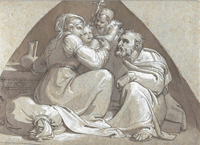 A considerable number of drawings have made their way into the collection of the Prints Cabinet over the years, where they
are kept unbound, just like the prints. Apart from the works of the Ashby and Gismondi collections, which have their own autonomy, there are a number of other drawings representing various epochs,
techniques and artists. Among the most precious works is Tommaso Minardi’s large pencil and charcoal reproduction of Michelangelo Buonarroti’s Last Judgment in the Sistine Chapel, donated to the Library by
Pope Pius IX. Also within the collections are numerous drawings by artists of various periods, including many from the eighteenth and nineteenth centuries. Fine works of the twentieth century
include those of Francesco Messina and the watercolors of Sigfrido Bartolini.
A considerable number of drawings have made their way into the collection of the Prints Cabinet over the years, where they
are kept unbound, just like the prints. Apart from the works of the Ashby and Gismondi collections, which have their own autonomy, there are a number of other drawings representing various epochs,
techniques and artists. Among the most precious works is Tommaso Minardi’s large pencil and charcoal reproduction of Michelangelo Buonarroti’s Last Judgment in the Sistine Chapel, donated to the Library by
Pope Pius IX. Also within the collections are numerous drawings by artists of various periods, including many from the eighteenth and nineteenth centuries. Fine works of the twentieth century
include those of Francesco Messina and the watercolors of Sigfrido Bartolini.
PHOTOGRAPHIC COLLECTION
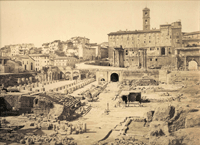
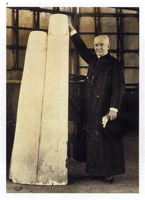 The Prints Cabinet also has a prestigious Photographic Collection with photographs from the nineteenth and twentieth centuries. It is subdivided into albums and loose photographs, and is
arranged according to format.
The Prints Cabinet also has a prestigious Photographic Collection with photographs from the nineteenth and twentieth centuries. It is subdivided into albums and loose photographs, and is
arranged according to format.
The collection documents the history of the Popes from Pius IX to John Paul II. Its primary focus is to document celebrations, travels and other episodes in the life of the Popes, as well as
the various places inside the Vatican. A large part of the Photographic Collection is made up of works which were sent to the various Popes by missionaries throughout the world, by various dioceses and also by
private individuals: these photographs document different places, events, institutions and people which have a great importance for the history of the Church, as well as for the history of fashion in
the nineteenth and twentieth centuries. The Photographic Collection is now being organized and a general inventory will be made available in the near future, together with a volume including a selection of
the most interesting items in the collection.
FONDO ASHBY
The Ashby Collection is one of the most important of all those preserved in the Prints Cabinet. Its name derives from the person who gathered it, the English archaeologist Thomas Ashby (1874-1931),
a well-known figure in Roman circles at the beginning of the twentieth century and one of the first students of the British School in Rome, of which he later became Director from 1906 to 1925.
The collection is made up of drawings (see above) and prints. The more than 7,000 prints included in the collection make it particularly interesting to scholars and archaeologists of the topography of Rome,
the Latium and Italy. Thanks to the eclecticism that characterized Ashby’s life and studies, the collection also includes works of the Old Masters of Italian and foreign schools, as well as works on
fashion and other very diverse disciplines.

This collection represents an interesting witness to the kind of “scientific” collecting which, at the end of the nineteenth and the beginning of the twentieth centuryes, saw the development of important collections
(e.g. that of Rodolfo Lanciani) which were themselves an essential component of the collector's work (as an archeologist, art historian or topographer) and which therefore must be considered a work instrument
rather than an amateur collection. The Vatican Library acquired the collection from the archaeologist’s widow in 1933, along with an important group of drawings, after very long and complex negotiations
involving the Pro-Prefect of the Vatican Library, Eugène Tisserant, the British School in Rome, the archaeologist Giuseppe Lugli, and the scholars Lamberto Donati and Augusto Calabi. Among the great number of
artists whose works are held within this collection, we may note Agostino Veneziano, Beccafumi, Beatrizet, Cavaleriis, Dupérac, Fontana, Lafréry, Nieulandt, Cock, Della Bella, Falda, Galestruzzi, Greuter, Mercati,
Schenck, Silvestre, Cooper, Cunego, Edwards, Morelli, Sandby, Vasi, and Volpato. The Piranesi collection is "almost complete for all of his works, and made up entirely of loose sheets".
From the nineteenth century, the collection holds works of Acquaroni, Angelini, Amici, Carloni, Cassas, Durat, Fea, Lindermann, Nibby, Pinelli Paoletti, Rosa and others.
As already mentioned, the collection includes not only topographic and landscape pieces, but also a rich section of Old Masters' engravings, including those of Giulio Bonasone, Parmigianino, Mantegna, Antonio Tempesta,
Zoan Andrea, Albrecht Dürer, Lucas van Leyden, Enea Vico, Andrea Andreani, and Goltzius. The well-known engravings of Antonio Lafréry’s Speculum Romanae Magnificentiae, of which Ashby collected several copies,
bound as well as in loose sheets, are of particular value. Most of the engravings of the Ashby Collection do not have an autonomous call number within the Prints Cabinet, but have been placed among the Prints
Collection (a concordance is included in a book being prepared for publication by B. Jatta). The Piranesi collection and the collection of Panoramas of Rome are exceptions, however, and have their own shelf-marks.
The works collected by Ashby may be identified by a round ink stamp which was placed on the verso of each work when it arrived in the Library.
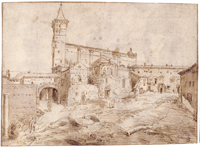

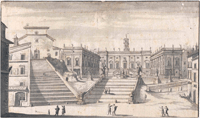 The drawings of the Thomas Ashby collection became part of the Vatican Library in 1933, along with the illustrious English scholar’s collection of engravings. The Ashby collection of drawings is important for
the study of landscape painting and of Roman topography because it includes numerous works by Italian and foreign artists of the sixteenth to the twentieth centuries who are particularly noted for this type of work.
The collection includes a great number of drawings from Italian artists such as Paolo Anesi, Stefano Della Bella, Giovanni Battista Busiri, Canaletto, Giovanni Francesco Grimaldi, Andrea Locatelli,
Crescenzo Onofri, Bartolomeo Pinelli, Giovanni Battista Piranesi, Giacomo Quarenghi, Luigi Rossini, Antonio Senape e Giuseppe Valadier. Among the foreign artists to whom works of this collection
are attributed are Jean Asselyn, Ferdinand Becker, Louis Gabriel Blanchet, Bartholomeus Breemberg, Lievin Cruyl, Etienne Dupérac, Philipp Hackert, George Hoefnagel, Christophe Kniep, Claude Lorrain,
Victor-Jean Nicolle, Adrien Van Nieulandt, Israel Silvestre, Richard Wilson, Gaspar Van Wittel and many others.
The five famous volumes of drawings of the Appian Way by Carlo Labruzzi (1748-1817) which are now preserved in the manuscript collection (Vat. lat. 14929-14933) were also once part of the Ashby collection, as
was the volume of drawings of the Via Latina by Richard Colt Hoare (1758-1838) (now Vat. lat. 14934). The Collection also includes works of such highly acclaimed artists as Guercino, Federico Barocci,
Gian Giacomo Caraglio, Domenico Passignano, Ciro Ferri, and Salvator Rosa, indicating that the collector’s interest was not limited to landscape and topographic drawings. Yet another component of the Ashby
collection is a substantial group of drawings and watercolors of various nineteenth century artists, which is now being inventoried.
The drawings of the Thomas Ashby collection became part of the Vatican Library in 1933, along with the illustrious English scholar’s collection of engravings. The Ashby collection of drawings is important for
the study of landscape painting and of Roman topography because it includes numerous works by Italian and foreign artists of the sixteenth to the twentieth centuries who are particularly noted for this type of work.
The collection includes a great number of drawings from Italian artists such as Paolo Anesi, Stefano Della Bella, Giovanni Battista Busiri, Canaletto, Giovanni Francesco Grimaldi, Andrea Locatelli,
Crescenzo Onofri, Bartolomeo Pinelli, Giovanni Battista Piranesi, Giacomo Quarenghi, Luigi Rossini, Antonio Senape e Giuseppe Valadier. Among the foreign artists to whom works of this collection
are attributed are Jean Asselyn, Ferdinand Becker, Louis Gabriel Blanchet, Bartholomeus Breemberg, Lievin Cruyl, Etienne Dupérac, Philipp Hackert, George Hoefnagel, Christophe Kniep, Claude Lorrain,
Victor-Jean Nicolle, Adrien Van Nieulandt, Israel Silvestre, Richard Wilson, Gaspar Van Wittel and many others.
The five famous volumes of drawings of the Appian Way by Carlo Labruzzi (1748-1817) which are now preserved in the manuscript collection (Vat. lat. 14929-14933) were also once part of the Ashby collection, as
was the volume of drawings of the Via Latina by Richard Colt Hoare (1758-1838) (now Vat. lat. 14934). The Collection also includes works of such highly acclaimed artists as Guercino, Federico Barocci,
Gian Giacomo Caraglio, Domenico Passignano, Ciro Ferri, and Salvator Rosa, indicating that the collector’s interest was not limited to landscape and topographic drawings. Yet another component of the Ashby
collection is a substantial group of drawings and watercolors of various nineteenth century artists, which is now being inventoried.
GISMONDI COLLECTION
The Gismondi Collection takes it name from the sculptor Tommaso Gismondi (1906-2003), who gathered a collection of works of art over the course of his life. Gismondi, a major figure in Italian sculpture of the twentieth century, was closely associated with the Vatican through the many commissions he received during his long career. He had a particular connection with the Vatican Library, for which he made the bronze Portone d’ingresso, or Entrance Door (1985), with eight panels in high relief representing the arts and sciences, and the bronze statue of St. Joseph with Child (1981) in the courtyard of the Library. The Gismondi Collection is made up of prints, drawings, copperplates, books, paintings, ceramics, porcelains and other artistic materials. It includes about 2,500 engravings by various artists from the sixteenth to the twentieth century. Among these there are works of Rembrandt, Jacques Callot, Stefano della Bella, Volpato and about one hundred geographic prints. There are about 300 drawings by different artists from the sixteenth to the nineteenth centuries. Among these should be noted some sketches from the Venetian School of the eighteenth century; numerous drawings by various artists from the nineteenth and twentieth centuries (including a valuable group of sketches by Marco Barberis), and drawings by the hand of the maestro himself. There are also 29 xylographic plates with religious themes, the only collection of this kind in the Vatican Library, which can be dated between the sixteenth and eighteenth centuries. The collection also includes some sixty panel and canvas paintings, about 150 printed books and about ten manuscripts.
BARTOLINI COLLECTION
Sigfrido Bartolini (Pistoia, January 21, 1932 - April 24, 2007), painter, engraver and writer, was one of the protagonists of Italian graphic art of the twentieth century. He has been featured in over fifty personal exhibitions in various Italian cities – Rome, Milan, Turin, Venice, Florence – and abroad – United States, France, Spain, Germany, Greece – which were noted and reviewed by the most authoritative critics. In 1966, together with Barna Occhini, he founded the fortnightly publication «Totalità» (a continuation of «La Voce» and «Lacerba») to which he contributed original writings and woodcuts. Tireless in his technical experimentation, Bartolini has illustrated dozens of books, including works by Bernard of Clairvaux, Vieira, Petrocchi, Serpieri, Savinio, Cattabiani, Nemi and Beatrice di Pian degli Ontani; and also the Gospel, on the occasion of the Jubilee of 2000. In 1983, he curated the monumental edition of Pinocchio with which the Fondazione Nazionale Carlo Collodi marked the centenary of the work's publication, illustrating it with over three hundred woodcuts in black & white and in color, the result of twelve years of work. Objects which bear witness to the efforts which the artist put into this work – preparatory studies, drawings of objects, wood carvings and test prints – were assembled into a successful exhibition that has toured the world. Some of the writings of this influential author, critic and polemicist, who worked closely with the daily newspapers «L'Indipendente», «Il Giornale» and «Libero» were collected in the book La Grande Impostura (Polistampa 2002). He has written essential monographs on the engravings of Soffici, Sironi, Innocenti, Lega, Rosai, Cremona, Boldini and others. In the period from March to April 2000, in the Palazzo della Triennale in Milan, the Region of Lombardy dedicated to him an extensive retrospective exhibition. His graphic works are found in the Prints and Drawings Cabinet of the Uffizi, in the Vatican Library and in the Bibliothèque Nationale in Paris. His latest work consists of fourteen stained glass windows for the Immacolata church in Florence, which were inaugurated in December 2006.
The extraordinary donation of a selection of 100 of his most significant graphic works (including woodcuts, lithographs and intaglio prints) which was made last November by the family of Sigfrido Bartolini to the Library of the Pope is an important contribution to the collection of contemporary Italian graphic art in the Vatican Library's Prints Cabinet.
The collection is named Bartolini Collection.
BIANCHI BARRIVIERA COLLECTION
Lino Bianchi Barriviera, drawer, painter and engraver, was born in Montebelluna (Treviso province) in 1906 and died in Acilia (Rome province) in 1985. After the first years of youth, he lived in Venice and in Florence, then in 1935 he settled permanently in Rome. The artist's fame is mainly due to his vast production of engravings, including more than 950 works, for which he mainly used the etching, but also many other techniques. He was also a master in several other art forms, primarily oil painting but also fresco and tempera painting; wood carving; glass work; mosaics; ceramics; metal embossing; engravings for postage stamps; and the creation of jewelry. From 1937 to 1955 he held the chair of engraving at the Academy of Naples, and he served as Director of that Institution from 1950 to 1954. From 1956 to 1976 he taught at the Academy of Fine Arts in Rome.
In April 2011, his heirs decided to donate to the Vatican Library a substantial group of 112 matrices (and about 112 prints made from them). This selection, made by the heirs with counsel from officials of ING (who have received the main part of the collection of matrices), was focused mainly on images of sacred character and on some landscapes of Rome and its surroundings.
The collection is named Bianchi Barriviera Collection.
MOEDE JANSEN COLLECTION
Moede Jansen (b. Osnabruck 1921), painter, portraitist and drawer, decided to donate to the Vatican Library an important group of her own drawings which probably constitute the most important elements in her artistic production.
The artist produced portraits, of similar type and identical format, of over two hundred illustrious people from the ecclesiastical, artistic, business and other fields. She took great care and employed great artistic skill in reproducing the physical features of these people, mostly from Germany but also from other countries.
Among the subjects, besides the Holy Father Benedict XVI, we also find various Cardinals of the Holy Roman Church, including the Librarian and Archivist Card. Raffaele Farina.
The works arrived in the Library on February 2, 2011, and the Prints Cabinet is still in the process of identifying and inventorying them.
The collection is named Moede Jansen Collection.
RELATED PAGES
CONTACT DETAILS
- PERSON IN CHARGE Dr. Simona De Crescenzo: contact by email
- Telephone: +39/06698.79421
- OFFICE: contact by email





